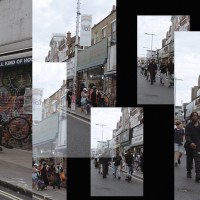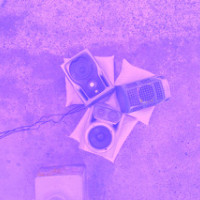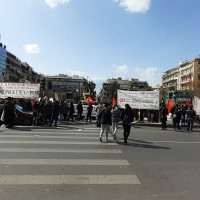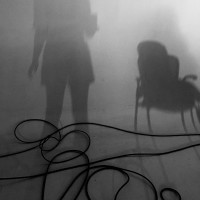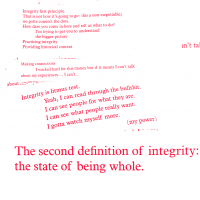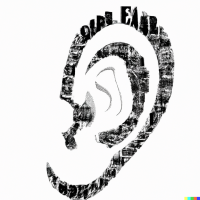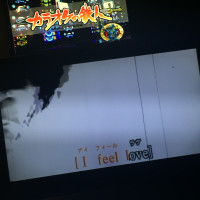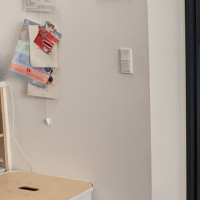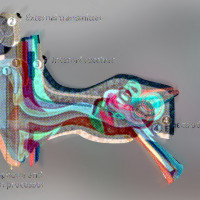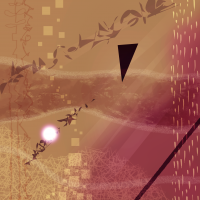WHAT SOUNDS DO
Oscillating concepts and challenging experiments: Reflections upon editorial work on audio papers
Sounds are always present: They surround and permeate us, solidifying, dissolving, and complicating relationships. Through genuine agency, sounds can articulate protest or approval, serve as a political statement or thought, and forge connections between people, entities, and environments. This special issue of audio and research papers aims to chart new directions in an anthropology of sound (Schulze 2021) - focusing on the interpersonal, social and political. What can sound do? What agencies and articulations do sonic events and practices mediate (LaBelle 2018)? In what ways does sound function as protest or resistance? What personae are sonically performed – in historical eras, in the present, or in the near future (Schulze 2018)?
*
In our call for paper for this special issue, we addressed a series of inquiries and considerations ranging from social relations and their cultivation through the medium of sound – as exemplified by practices such as Deep Listening, proposed by Pauline Oliveros (Oliveros 1974); how sonic sensibilities can contribute to the development of new fields of knowledge, as explored by Salomé Voegelin (Voegelin 2021); and we asked how a sonic discourse develops within cultural landscapes that extend beyond the boundaries of the Western tradition, as outlined by Dylan Robinson (Robinson 2020)?
We faced a series of questions concerning the audio papers that are more unusual for academic journals
We received a large number of papers on a wide variety of topics. What followed were conversations among us as an editorial group of four, as well as exchanges with our many international scholars who reviewed these contributions. Two scholars or artists anonymously and independently reviewed each submission, and each member of our editorial team served as a curator with full responsibility for a handful of papers. After our intensive peer review process, we engaged in conversations with the authors and producers about their revisions, and as a final step, some of the revisions inspired even more discussion within our editorial group. Thus, the written and produced papers are essentially also a product of many conversations and comments, doubts and convincing arguments, revised versions and editorial remarks. So far, this is a fairly common and generic process for any peer-reviewed journal issue.
During these discussions, however, we faced a series of questions concerning the audio papers that are more unusual for academic journals as they redirected our attention back to the format of academic publishing. Those doubts and critical sensibilities brought us to reflect upon various aspects of the concept of the audio paper.
We asked ourselves: How can authors and producers balance the required sonic argument with a more traditional, scholarly and verbal argument? Whereas the sonic argument defines an audio paper at its core, the careful, erudite and critical reflection upon historical ramifications and conceptual consistency is foundational to any academic research. The authors’ goal to achieve both seemed at times almost unachievable -- or at least only in an oscillation, swinging back and forth between both extremes, between sonic materiality and conceptual rigor.
Few of the audio papers we received argued, though, very convincingly through verbal arguments, through referencing existing academic research, and reflecting conceptual consistency. In some of those papers we noticed a certain lack in engagement with actual sonic qualities of the phenomena investigated. Should we recommend to the producers to work even less with verbal references and a critique of concepts and more with analyzing a sonic phenomenon, in a sonic and non-verbal manner? And how could the producers manage to do that?
Can a rather short piece of audio pack as much in and in the same way as a written paper?
Many more papers to the contrary were intensively focusing on a sonic performance with sound. As an effect, some among our reviewers but also within our editorial team were excited about this actual sonic materiality performing an argument, whereas others had doubts, if this indeed constitutes an audio paper – or if more academic work including referencing, conceptual critique and historical reflection were to be required?
We arrived at an issue that questions the ambition and the potential of the audio paper: Can a rather short piece of audio pack as much in and in the same way as a written paper? And what are the more specific ways of producing and performing by which an artist working with sound can indeed create an artistic or poetic expression that a text based, and verbal argument cannot? Can an audio paper actually fail to make a sonic argument, while also be worth publishing due to what it proposes to do within this experimental format?
The audio papers we publish in this special issue risk experiments and daring explorations. They work with the format, they explore options for sonic performativity – and we hope that they will inspire you, the listeners, artists, producers, scholars, researchers. What else could sound do?
*
The fourteen audio and research papers of this special issue offer a journey into a broad planetary diversity of sonic experiences and practices. At the same time, they mark this historical moment in the early 2020s with its aesthetic, technological, social, and political challenges to sonic performativity.
In More than Background Francisco Mazza explores the acoustic territory of London’s Peckham Rye Lane with and for us. We join the sound artist's journey and can listen with and through his recording practices and production skills. We hear the voices of residents, of activists, we listen to sounds in the public realm, we actually participate in community meetings, and we are involved and enmeshed in the sounds of public transport, of shopping streets, of engines and loudspeakers, of buskers and streamed audio in the public realm. An idiosyncratic position within this community space is convincingly articulated, produced, presented, and reflected. The background has agency and presence. It speaks.
Morten Poulsen’s audio paper Fear of Weakness: Songs to Agitate the Man presents various layers of experimenting with how gender is performed through the sonic. The most provoking is surely the breach of protocol for how scholarly masculinity is performed in academia. We hear the softly spoken voice of the author, presenting the content of his paper. This voice, however, is broken up intermittently with giggling and a shaky tremble, interrupting his verbal flow. The assumed authority performed by an academic author, his voice itself, becomes living material for the sonic topic to reside. As a result, the object distance between author and subject is collapsed. Can we, as listeners, still trust this speaker – or is also our trust in his argument collapsing? Or is this collapse even the goal of the author’s performance?
In Ania Mauruschat’s audio paper, The Heartbeat of the Drum, she takes on the challenge of presenting what might be considered a mere musical instrument: a frame-drum, the Qilaat. But instead she gives a sense of a cosmology, a world view that the playing of the Qilaat enacts so strongly as to disrupt power relations, while it strikes a fundamental chord in those who listen. Letting the drum’s sound resonate into dimensions of the spiritual, political, historical, we are able to grasp the agency it has in the present context of Kalaallit Nunaat, the Greenlandic struggle and survival. With Kalaallisut, the Greenlandic language being foregrounded in the audio paper, people who cannot understand this language – like us, the editorial team -- are clearly situated outside the frame of understanding: in this way this audio paper performs and respects a line of decolonial demarcation.
In The Limitations of Sonic Offer, Vita Zelenska examines the political role of sound through recordings of the 2020-2022 Athens protest in solidarity with migrants and refugees. The resonance of slogans at demonstrations evokes an undeniable bodily response, laying bare the vulnerability inherent in sonic activism. This vulnerability, in turn, elicits immediate affective responses, highlighting the discrepancies between language and affect in the context of solidarity through sound. This thesis is supported by additional autoethnographic material from a demonstration against the Russian invasion of Ukraine, which also offers an intimate look behind the scenes of institutional knowledge production. Within this framework, Zelenska delves into the contest of voices transforming public spaces, unveiling how sonic agency offers both opportunities for understanding and forms of solidarity that, in their opaque decipherability, can lead to incongruous outcomes. The audio paper intriguingly begins with the sounds of children playfully asserting their ownership of the square, setting the tone for the exploration in a generally distinctive and ingenious use of sound as both medium and content to support and present the argument. The narrator's deliberate vocal fluctuations mirror the nuanced approach they describe, providing context and depth beyond the thesis, alluding to further avenues of exploration.
Andromachi Vrakatseli’s research paper, The Human Body as a Space Defining Element of Sound Art continues the work with the body as a site for production of meaning – in this case, though, within the context of exhibitions of sound art. Working through a range of aspects of the perceived space in sonic events, Vrakatseli attempts to describe the mechanisms that produce private or public space, cues for navigation, conditions for the living body to be both subject and object of the works in question. How do these spaces guide us into listening – or how do they provide a detour?
New technologies speak to us, literally
Olya Zikrata's twofold contribution develops in textual and sonic formats. Sound as Shield: Doing Ukrainian Self-Defense, is an essay that explores Ukrainian resistance to Russian colonialism. Through Ukraine's historical experience, it focuses on how speech and action create the conditions for life, and how a protocol for collective survival occurs through oral actions that engage the insurgent collectivity of shared speech. Drawing from and cross-referencing black politics, the essay evolves into a performative and idiosyncratic text that questions war and peace, articulating a stance with a confrontational yet poetic perspective through an affirmative politics of sound life relevant to Ukrainians.
The audio paper The Second Sound of Integrity: Us Whole was created by Emery Petchauer and Ruth Nicole Brown, both professors at Michigan State University, in collaboration with three Indigenous and Black collectives, none of which are funded by the government: Saving Our Lives, Hearing Our Truth (SOLHOT) in Chicago and Champaign, Fire in Little Africa/The Space Program in Tulsa and Oklahoma City, and The Aadizookaan in Detroit. Over the course of nine months, they explored integrity in the sense of wholeness within these groups both online and offline, recording more than twenty hours of conversations on the topic. In addition, they gathered ritual scripts, original sound compositions, samples, voice memos, and more. Following the ideas of performance scholars Sandra Ruiz and Hypatia Vourloumis on formlessness, the collaborators created a multi-layered audio paper from this material. Their track consists of nine borderless vignettes that »pulse, converge, resonate, and dissolve into each other,« as they aptly describe it in their accompanying abstract. Sounds serve here as a means of experimenting with formlessness as an anticolonial strategy. At the same time, the formless formation of this audio paper explores and makes audible radical, independent forms of being together and in solidarity.
The exploration of listening guidance is taken up in Vadim Keylin’s research paper The Lyric Ear. He explores and analyzes the potential of listening scores that provide the reader with a set of instructions for how actually to listen. But how can a written recipe indeed guide its readers to assume a peculiar position and approach to listening? Keylin focuses on listening scores by composer Pauline Oliveros and demonstrates how these scores can be considered a kind of poetry situated between a range of media formats. In his understanding a reader’s subjectivity is questioned through these works. As a reader I become a listener, and I hand myself over to the guidance of the author and composer.
The audio paper "TO WHOM IT MAY SPEAK": scenes of Ukrainian truth, and terror explores the impact of Russian aggression on Ukrainians, focusing on the sonic state and worldly entanglement of ruination – the experiences of war victims are reported here in their »cruel« and »poor« sonic qualities, hastily recorded in Mariupol, Chernihiv, Kharkiv, and Kyiv. The author Olya Zikrata uses graphic sounds to ground the discomfort of ear-witnessing and listening attentively to the violence of war, tracing her own experience of speaking Ukrainian to their father in Russian-speaking Crimea, where non-Russian expression is heavily policed by the occupation authorities, and reflections on the nature of Surzhyk. The two papers converse with each other in a cycle of theoretical inquiry and first-person accounts, now with discomforting confrontation, now with poetic force.
In their research paper Democratic noise: Improvisation, democratic conversation and Free Jazz Mod Paludan, Jakob Kjær Bødker and Zenia Børsen focus on a specific case study to investigate the agency of noise/music: a rally of the Danish-Swedish far-right extremist, Islamophobic and racist politician Rasmus Paludan, which was disrupted by the noisy improv-sessions of the participants of the counter-manifestation of Free Jazz Mod Padulan (FJMP) in spring 2020 in Odense, Denmark. By drawing on Jürgen Habermas’ theory of communicative action Bødker und Børsen discuss the empirical material documenting this politically intervening event and the findings from the interviews they made with four demonstrators about it. Thus, they elucidate the democratic potential of noise/music as a communicative social interaction on the macro-, meso- and micro-level of sociality with findings about the collective experience of making noise together, the protective power of noise, and it’s potential for disarming bullshit.
The audio paper by Ragnhild May and Kristoffer Raasted presents reflections and sound performances around and with the genre of Karaoke in the form of a Karaoke Collage. Both producers start from the experience of spending a lot of time in karaoke boxes in Tokyo. From this experience, they take us into the peculiar non- or even anti-virtuosity of performing evergreen pop songs. Are we perhaps still mere spectators, singing along and entering a deep parasocial relationship with the artist in question when we sing karaoke? May and Raasted ask: Isn't the point that you don't know what you're singing or what it means? The tropes of pop evergreens are fused into a pastiche of all karaoke songs. Is this collage a compressed diamond of everything that pop could be? »Love. Baby. Yeah. Wanna. Girl. Time. La. Feel. Night. Ooh. Hey. Life. Na. Heart. Tonight.«
New technologies speak to us, literally. But how do older users actually live with these, and which affects are involved here? What can they do with these sounds and what can these sounds do with them? Marie Ertner, Stina Hasse Jørgensen, Signe L. Yndigegn present in their audio paper Voice as Infrastructure how nine people over the age of 65, living in Copenhagen, live alongside and through new technologies in their homes and everyday lives. The affective relations in their homes are altered significantly, which becomes tangible in this contribution.
Andile Lindokuhle Sibiya and Kevin Gordon investigate operating rooms’ sounds in Cochlear implantation surgery: Soundscapes, Textures, and Manipulations, concentrating on cochlear implantation surgery in an operating theatre. The soundscape is grounded in critical affect theory and incorporates ideas from medical sociology and sound studies, while attempting to avoid the easy fetishization of cochlear implants noted in Deaf Studies. The interviews and voiceovers take the listener through the first stages of the procedure, highlighting specific parts of the operating room soundscape and sonic parallels to expand our awareness of the agency of sound in the interrelationship of individuals, tools and equipment, what has been described as 'critical affective agency'. The layering of human and non-human sounds emphasizes the flow of irregularities and coordination deployed for the success of the operation. The research recognizes sounds as intrinsically important players in the restoration of sound perception and as a critical component of the operating room team.
Carlos Manrique Clavijo's audio paper, Dynamics of Power Dynamics, discusses and performs constructs of power in relation to sonic storytelling. The author considers the effects of this form of storytelling in relation to the suspension of belief and the audience's interpretation of meaning. Loudness is treated as a means of demonstrating a particular kind of hegemonic power, which is clearly challenged by the power of silence: how do both loud and quiet sounds exert power? This audio paper translates this question into dynamics within a time-based sound work. »The greater the resistance, the greater the power.«
*
With this special issue, we aim to contribute to the discourse in sound studies on how sound and sonic practices, in their experimental and performative capacity, address issues in the anthropology of sound.
At this point, we would like to thank the many contributors who worked so hard on their papers, submitted them to us, and then worked on them again after receiving feedback and advice from our reviewers. We can feel all the energy and care, all the knowledge and skill, all the time and reflection that went into your work. On more than one occasion, we have felt simply showered with gifts as we read or listened to your contributions.
We would also like to express our deep gratitude to all the colleagues, artists, and scholars who supported our work on the way to the realization of this special issue with their reviews, their expertise, and their experience in publishing works and advising researchers and artists. Without the substantial reflections and recommendations of thirty scholars from Denmark, Great Britain, Sweden, Ukraine, the Netherlands, Canada, Finland, Poland, the United States, and Germany, this special issue would not have been possible at all. Your efforts are, in fact, the main formants of this anthology of audio papers and research papers.
Finally, we would like to thank the Carlsberg Foundation. The financial support of the Carlsberg Foundation made the conference WHAT SOUNDS DO: New Directions in an Anthropology of Sound at the Rhythmic Music Conservatory on September 13-16, 2022. This conference paved the way for further work on this special issue. For us, the editorial team, the debates and performances, the dissenting statements, the collective agreements and the convivial moments that took place at the conference will in fact continue on this issue. Therefore, we are also immensely grateful to Seismograf for giving us the opportunity to publish these works in this journal.
Bibliography
LaBelle, B. (2018) Sonic Agency. Cambridge/MA: The MIT-Press
Oliveros, P. (1974) Sonic Meditations. Sharon/VT: Smith Publications
Robinson, D. (2020) Hungry Listening: Resonant Theory for Indigenous Sound Studies. Minneapolis/MN: University of Minnesota Press
Schulze, H. (ed.) (2021) The Bloomsbury Handbook of the Anthropology of Sound. New York: Bloomsbury Academic
Schulze, H. (2018) The Sonic Persona: An Anthropology of Sound. New York: Bloomsbury Academic
Voegelin, S. (2021) Sonic Possible Worlds – Revised Edition. New York: Bloomsbury Academic
